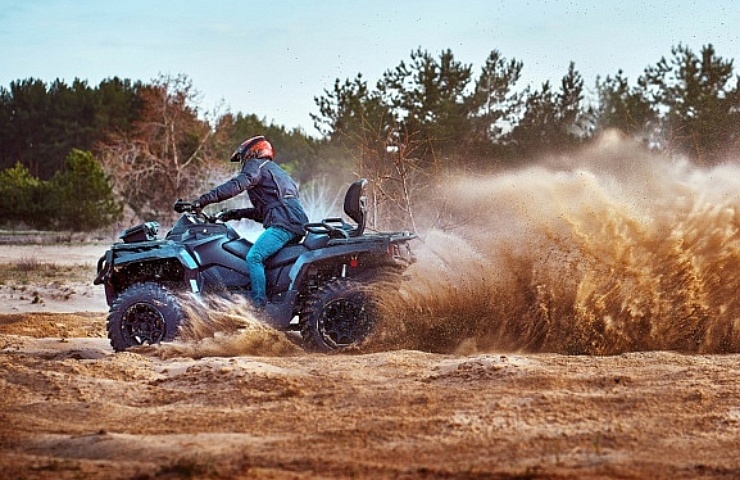Contents
ATV Tires Versus UTV Tires
ATV tires may look the same as utility terrain vehicle (UTV) tires, but ATVs—also known as quads—have lower tire load and durability requirements. ATVs are lighter and carry fewer passengers and less cargo, so their tires also tend to be lighter and are built to match the ATV’s lower overall horsepower.
UTVs are more carlike, with bucket seats, a steering wheel, and foot controls. That means UTVs require a more heavy-duty tire with a higher ply rating than most ATV models.
Selecting the appropriate tire for your ATV depends on the terrain you plan to navigate. There are tires designed for a vast array of conditions—from racing and mudding to sand and niche terrains.
Choosing new ATV tires that match or surpass the stock load-carrying capacity and ply rating of your current ATV tires is essential. This ensures better protection against flats and punctures while optimizing ride quality.
Read: Expert Guide to UTV Tire Sizes and Types
ATV Tire Sizes

Front tires: 26 x 8 x 14
Rear tires: 26 x 10 x 14
- The first number (26) is the tire’s height in inches.
- The second numbers (8 and 10) are the tire widths in inches.
- The third number (14) is the wheel diameter the tires are mounted to in inches.
Running different front and rear tire sizes, known as staggered tire sizes, is typical for many ATV models off the showroom floor. Using narrower tires in the front and wider ones in the rear helps ATVs that don’t have power steering to steer more effectively while boosting rear wheel grip.
There’s also the square tire setup, where all four tires are identical in size. Many modern ATVs have power steering and can be set up this way.
Shop now for ATV tiresFeatures to Look for When Buying ATV Tires
Tire Size
Make sure you know the current sizes of your ATV tires before buying. Stick to the same size unless you’re considering a brand-new tire and wheel combo. Changing the stock tire size can impact your machine’s handling, comfort, traction, and factory warranty.
Tread Pattern and Depth
Consider the terrain you’ll be riding on—such as mud, sand, rocks, or gravel— and choose a tire model with a tread pattern tailored to that terrain. Soft terrain requires a deeper tread, whereas hardpack conditions do better with a shallower tread depth and less aggressive design. If you tackle diverse types of terrain, consider an all-terrain tire built for versatile all-around performance, much like all-season car tires.
Construction
ATV tires typically come in two main construction types: bias-ply and radial. In bias-ply tires, cords within the tire’s body crisscross diagonally, often in multiple layers or plies. While bias-ply tires are generally more affordable, they aren’t as durable as their radial counterparts. Radial tires have cord plies set at a 90-degree angle to the driving direction, radiating out from the tire’s center. Radials are the industry standard because they provide superior traction, a smoother ride, increased puncture resistance, and extended tread life.
Ply Rating
The ply rating of a tire indicates its strength, durability, and how well it can resist punctures. It also influences the tire’s ride and performance. A higher ply rating means the tire is more robust and durable, though it also adds weight. ATV tire ply ratings start at two-ply and go up to 10-ply for extreme conditions.
Brand Reputation and Price
While price is always a consideration when buying, it shouldn’t be the sole determining factor. It’s worth considering reputable brands known for producing durable, high-quality tires that can provide added confidence on the trail. Before making your tire purchase, research the tire brand and read customer reviews and feedback about the tire model.
Popular ATV Tire Brands and Models

Tusk Terrabite
Tusk Terrabite: Best for All-Terrain
The Tusk Terrabite ATV tire utilizes a truck-style tread pattern and premium rubber compound for excellent multi-surface performance and high-mileage wear. It has aggressive shoulder and sidewall tread bite in dirt, sand, and rocks.
Tusk Terrabite prices start at $160.

STI Out and Back Max
STI Out & Back Max: Best for Mud
STI Out & Back Max ATV tires have aggressive tread meant to plow through mud and muck with ease. Offered in a wide variety of sizes, these tires are built to survive sloppy, messy conditions and get you back home from the trail.
STI Out and Back Max prices start at $230.

Sedona Cyclone
Sedona Cyclone: Best for Sand
The Sedona Cyclone is a proven sand dune ATV tire with experience at sand parks in the US. These lightweight tires provide traction and flotation combined with more predictable turning and side-hilling that work excellently in dry and light, wet and heavy, and volcanic sands.
Sedona Cyclone prices start at $65.
Maxxis Razr2: Best for Racing

Maxxis Razr2
As a go-to tire for GNCC and WORCS racers, the Maxxis Razr2 is designed to work in various terrains but is best for intermediate to muddy and loose, hardpack desert conditions. Increased tread depth and angled shoulder knobs on the front tire offer improved steering and braking control.
Maxxis Razr2 prices start at $200.








